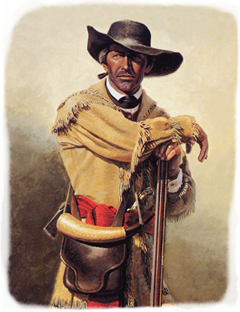Sgt. Timothy Murphy
The earliest American snipers were hunters first, then soldiers. They hailed from the frontier, where long-range shooting was a survival skill. Military muskets of the time were smoothbores, accurate out lo 50 yards or so-adequate for massed volley fire. But in the American wilderness, where one had to fight Indians and live off wild game, a weapon needed to be lethal at much greater ranges. So gunsmiths made long rifles with grooved barrels that gave spin to a ball, making it possible to fire accurately out to 200 yards and beyond.
Thus, weapons like the Pennsylvania long rifle changed war and gave rise to a new kind of warrior, the sharpshooter, who could engage his enemy from a concealed position far beyond the range of the massed, disciplined troops moving toward him in line, intending to finish him with bayonets. The British considered this form of warfare uncivilized or, at least, unsporting, particularly since Patriot sharpshooters often targeted officers. Snipers in those days could be selective about their victims. The range might be great, but the intent was up close and personal.
At a critical moment during the Oct. 7, 1777, Battle of Bemis Heights, part of the Saratoga campaign, an American sharpshooter shot British Brig, Gen. Simon Fraser out of the saddle as he was rallying his troops. This single shot turned the tide of the battle and inevitably took on mythic proportions. The soldier who reportedly fired the shot was Tim Murphy, one of Colonel Daniel Morgan’s Virginia sharpshooters- rough customers who dressed in skins and moved through the woods like smoke. The range of his shot was said to be anywhere from 300 to 500 yards- Later research cast doubt on whether the shooter was Murphy and whether the range was much more than 200 feet. Regardless, Fraser was mortally wounded, the Americans won the day, and a single shot by an expert marksman may have been the deciding factor.
During the Revolution, when a sharpshooter’s position was overrun, he was often not taken prisoner. And this was in a time of relatively “civilized” warfare, when prisoners were released on their word not to fight again and a general might accept his opposites surrender in the morning and entertain him at dinner that night. But snipers were, in a word, different. Men on both sides of the line feared and hated them.
The single long-range shot became the sine qua non of this new soldiering specialty-some would say calling- of military sniping. And as warfare became increasingly a matter of massed men and massed firepower, its aura grew. An individual could now strike the decisive blow in battle. But that individual had to be able to shoot.
Today’s weapons are vastly more sophisticated and powerful. The .50- caliber is now standard in a weapon designed specifically for shoulder fire by military snipers. Rob Furlong, the Canadian Forces corporal whose long shot now holds the record, used a .50- caliber sniper rifle. This weapon is also capable of disabling enemy vehicles and crew-served weapons. Thus, the sniper has become a kind of artilleryman as well as a rifleman, once again stretching battlefield tactics.
The cost to outfit a sniper today is much higher. As with everything in war-and civilian life, for that matter-technology seems to have transcended all other elements in the mix- No more iron sights. No more standard-issue rifles, jury-rigged for sniper work. No more personal arms like the Winchester Model 70 that Marine Lieutenant John George carried with him when he landed on Guadalcanal in 1943. George, incidentally, learned on his own something that had been taught to snipers in previous wars-”aim for the teeth.” That way, if you are a little off in your elevation, you’ll still make a killing shot.
But the core of the thing hasn’t changed. The sniper’s work is simultaneously personal and detached. He kills from long range but selects his targets and sees each person he kills, though the target almost never sees him. He is a hardwired hunter, descended from the first snipers, men who came out of the woods wearing buckskins, carrying Pennsylvania long rifles and looking to kill Redcoats. An American tradition
